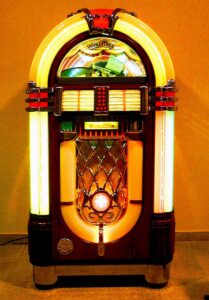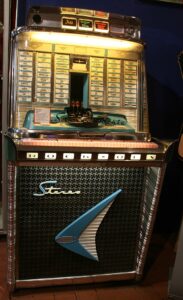The jukebox was invented in 1889. It was created by Louis Glass and William S. Arnold, who combined Edison’s phonograph with coin-operated technology to create an automatic music-playing machine that could play individual selections on demand. The jukebox quickly became popular in public places, such as bars and restaurants, and helped introduce people to a wide range of music styles, from classical to popular songs. The jukebox became an iconic symbol of American popular culture in the 20th century and continues to be a nostalgic reminder of the golden age of music.
Jukeboxes got their name from the original purpose of the machine, which was to play musical selections in juke joints. Juke joints were establishments in the rural South that served as social gathering places for African Americans in the early 20th century. These establishments often had a machine that played music, and the word “juke” was a colloquial term used to describe both the machine and the establishment itself.
Jukebox came from Juke Joints
When the coin-operated music machine was developed and commercialized in the 1930s, it was called the “jukebox” as a nod to its origin in juke joints. The term “jukebox” quickly became synonymous with the coin-operated music machine, and the jukebox became a popular form of entertainment in the United States. Their popularity continued to grow throughout the 20th century, and it remains an iconic symbol of American popular culture to this day.
The jukebox played a significant role in the development and popularization of rock and roll music. It allowed people to easily access and listen to the latest songs, helping to spread the genre and bring it to a wider audience. They also helped create new opportunities for musicians and record companies, as people could choose to play the latest rock and roll songs for a small fee. Additionally, the jukebox served as a social gathering place for young people, who would gather to listen to music and dance. This helped create a sense of community and culture around rock and roll, further solidifying its place as a genre of music.
Top Brands
There are a few iconic brands. Tops on the list is the Wurlitzer 1015. This classic jukebox was produced from 1954 to 1960 and was one of the most popular models of the early rock and roll era. It became a staple in diners, bowling alleys, and other public places.

A Wurlitzer 1015 featured on the television show “Happy Days”. The show was set in the 1950s and 60s, during the peak of the jukebox era, and the Wurlitzer 1015 was one of the most popular jukeboxes of that time. It became a fixture in many scenes on the show and became an iconic symbol of the rock and roll era and the nostalgia of the 1950s and 60s. The Wurlitzer 1015 remains a popular collectible item to this day and is often sought after by fans of the show and collectors of vintage jukeboxes.
The Seeburg company was a major player in the market and produced several popular models in the 1950s and 1960s. The Seeburg M100A was one of the company’s most successful models and became a fixture in many rock and roll-era establishments.

Rock-Ola also produced several popular models in the 1950s and 1960s. The Rock-Ola Tempo II was one of the company’s most successful models and was known for its stylish design and high-quality sound. And the Automatic Musical Instruments (AMI) companyproduced several popular models in the 1950s and 1960s. The AMI Continental was one of the company’s most successful models and became a staple in many rock and roll-era establishments.
These jukeboxes, along with others of the era, helped spread rock and roll music to a wider audience and played an important role in the growth and popularity of the genre.
45s Were The Key
Along with jukeboxes, 45 RPM records, also known as “45s,” were important to the jukebox industry because they made it easier for jukebox operators to change the records in the machine and offer a larger selection of songs to customers. Prior to the introduction of 45s, jukeboxes used 78 RPM records, which were much larger and heavier. This made it difficult for operators to change the records in the machine and limited the number of songs that could be offered. The smaller size and lighter weight of 45s made it easier for operators to change the records and offer a larger selection of songs to customers.

45s also allowed for the creation of a wider range of music genres, as artists and record companies could produce records specifically for the jukebox market. This led to the creation of more specialized music genres, such as rock and roll, R&B, and country, which helped drive the growth of the jukebox industry. In addition, 45s allowed for the production of inexpensive and disposable records, which were popular with young people and helped to spur the growth of the youth culture and music scene of the 1950s and 60s.
Overall, the introduction of 45s was a key factor in the growth and popularity of the jukebox industry, and helped establish the jukebox as an iconic symbol of American popular culture.
Music Everywhere
Jukeboxes were a common feature in restaurants, diners, and cafes during the 1950s and 60s, when the jukebox was at the height of its popularity. Almost every diner, drive-in, or soda fountain had one.These, along with many others, helped to establish the jukebox as an iconic symbol of American popular culture and contributed to the growth and popularity of the jukebox industry.
It is difficult to determine the most played jukebox song of all time as this information was not recorded or documented. However, some of the most popular songs that were frequently played on jukeboxes in the 1950s and 60s include “Rock Around the Clock” by Bill Haley & His Comets, “Great Balls of Fire” by Jerry Lee Lewis, “Johnny B. Goode” by Chuck Berry, “Tutti Frutti” by Little Richard, and “Hound Dog” by Elvis Presley.